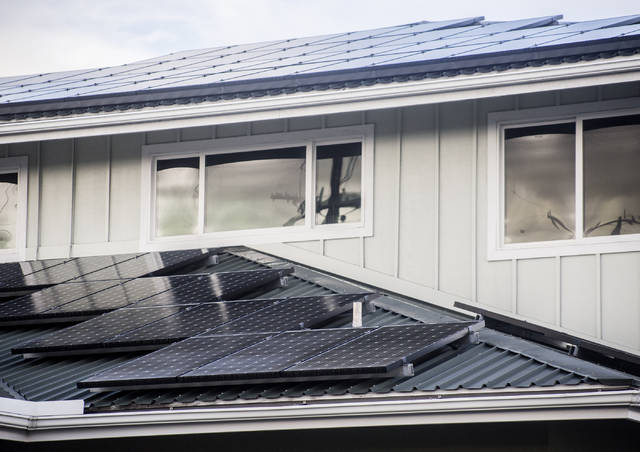HILO — Although more solar power than ever was generated statewide last year, the number of solar customers dropped throughout Hawaii Island.
Hawaiian Electric Cos. reported 109 additional megawatts of photovoltaic solar capacity were added across the state in 2017, for a total capacity of 695 megawatts. Despite this, the Hawaii County Department of Public Works issued 906 permits for photovoltaic solar projects in 2017, a 28 percent drop from the 1,256 issued in 2016.
Peter Shackelford, president of Renewable Energy Services in Honokaa, called 2017 a “survival year,” saying some of his competitors were unable to survive a significant decline in home solar installations.
Shackelford said 2017 “was a difficult year to be in solar.”
Marco Mangelsdorf, president of Hilo solar provider ProVision Solar, said the notoriously unpredictable solar market dropped not only in the four Hawaii counties — solar permits dropped by 12 percent on Kauai, 35 percent on Oahu and by 59 percent on Maui — but also in California, by far the most solar-friendly state in the country.
“Is it even possible to have a predictable market?” Mangelsdorf asked. “Is there a way to make this ‘solar coaster’ be less up and down?”
Shackelford attributed the decline in residential solar interest in Hawaii to a series of solar incentive programs that, in his opinion, have not provided sufficiently compelling reasons for people to switch.
In 2016, Shackelford said, the state Public Utilities Commission ended its net energy metering program, which credited users for energy exported back into the power grid. This program would award users with the full retail rate for each kilowatt-hour exported.
Shackelford acknowledged that net energy metering was “unfair” — those who couldn’t afford solar installations ended up subsidizing the rewards for those who could —but noted that, comparatively, the programs that replaced it have not proven to be solar-friendly.
Although the net energy metering program ended, its successor — a grid-supply program which also allowed users to export energy to the grid, albeit at a reduced price — continued to attract users, although that program reached its energy cap in late September and stopped accepting new users.
“That was the program that keeps on giving,” Mangelsdorf said. “But it won’t be doing much giving for much longer.”
With such programs at an end, Mangelsdorf said prospective solar adopters don’t have any “low-hanging fruits” to incentivize investing in a photovoltaic system.
Shackelford said an upcoming program, Smart Export, will allow users to store energy in batteries and export it during peak hours, but noted the small incentives for doing so — 11 cents per kilowatt-hour — might be unattractive in the face of expensive battery systems.
Meanwhile, the grid-supply program will continue with Controllable Customer Grid Supply, or CGS+, which allows users to export energy to the grid.
“We’ve always specialized in off-grid solar, which is why we’ve been able to stay alive,” Shackelford said. Even so, Renewable Energy Services, which provides off-grid and grid-dependent installations, had a difficult year, with profit margins dropping to negligible amounts.
Meanwhile, Build It Green, a Hilo-based off-grid solar installer, saw an upswing of about 10 to 20 percent in installations. Owner Mikale Hudson said the company installed hundreds of photovoltaic systems islandwide.
“People have been bit by the off-grid bug,” Hudson said.
Hudson said recent advances in solar storage technology, such as Tesla Inc.’s Powerwall, have made it easier to take a home completely off grid.
“More people are aware now that they can be their own power plant,” Hudson said. “These are exciting times for off-grid people.”
Despite the comparative stagnation of grid-dependent solar, Shackelford said he is somewhat encouraged for 2018. December saw a 52 percent increase in new solar installations on the Big Island from December 2016, a particularly notable boost during a typically slow month for the industry.
“I’m feeling a bit more sunshiny,” Mangelsdorf said, predicting an upcoming surge in net energy metering customers retrofitting their systems to completely break away from the grid as battery systems become more robust.
“2018 looks to be better, I think,” Shackelford said.
Email Michael Brestovansky at mbrestovansky@hawaiitribune-herald.com.

